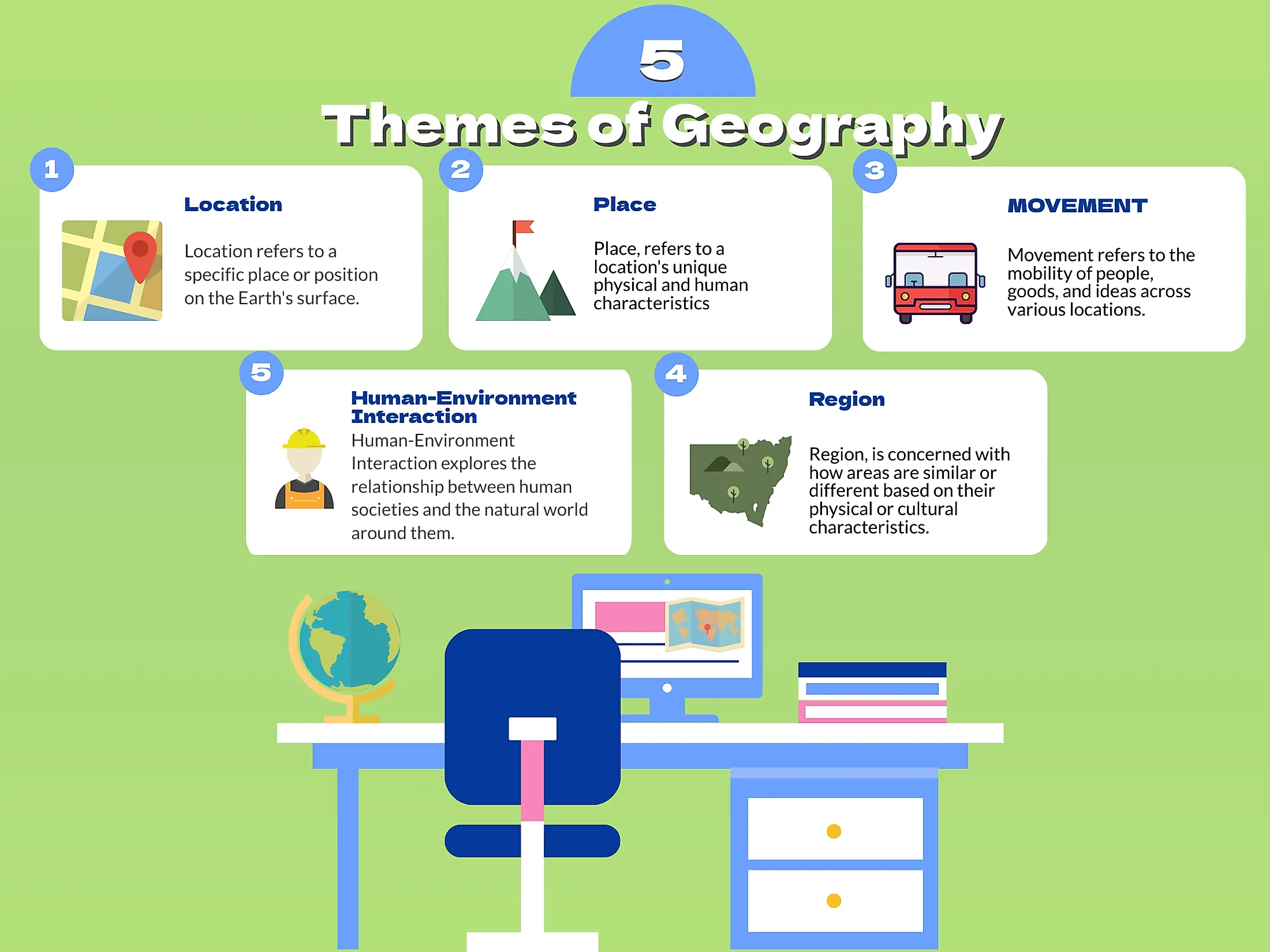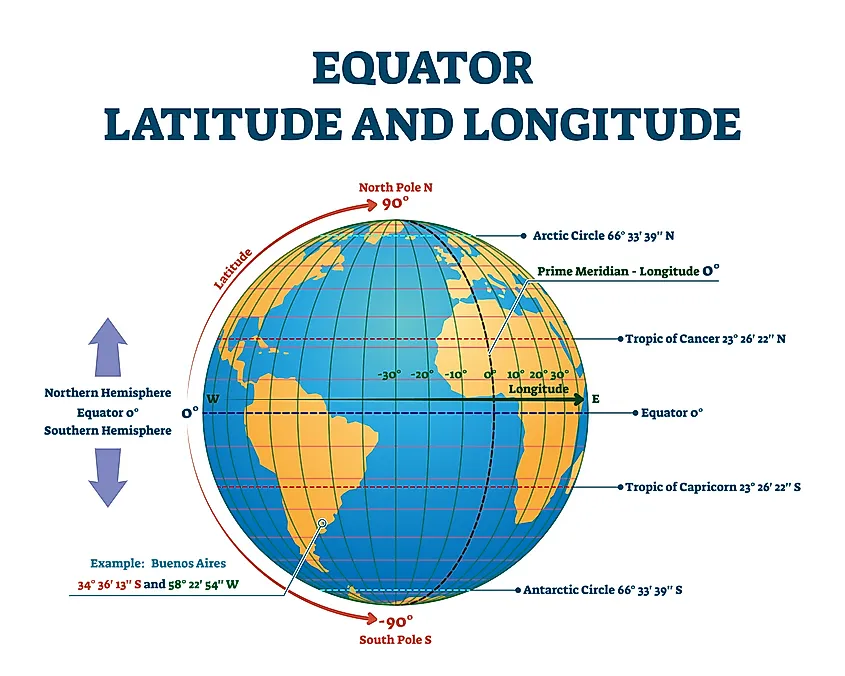
The Five Themes of Geography
Geography is a complex subject that encompasses multiple educational disciplines. It has been divided into five themes to facilitate the teaching of geography in schools and universities. Educators first introduced these themes in 1984, and they are utilized by the National Council for Geographic Education (NCGE) and the Association of American Geographers (AAG). The five themes are Location, Place, Human-Environment Interaction, Movement, and Region. Location refers to where something is on the Earth's surface. Place describes the unique physical and human characteristics of this location. Human-Environment Interaction explores how humans interact with their environment. Movement refers to the mobility of people, goods, and ideas across various locations. Finally, Region examines how places are similar or different based on their physical or cultural characteristics, ultimately allowing us to form tenuous groupings of these areas. These themes provide a structured approach to learning geography that helps students understand our world more deeply.
5 Themes Of Geography
Location

Location refers to a specific place or position on the Earth's surface. There are two types of location: absolute and relative. Absolute location refers to the exact location of a point on Earth's surface using latitude and longitude coordinates. An example of absolute location is the location of the Great Pyramid of Giza in Egypt, which is at 29.9792° N, 31.1342° E.
Relative location, on the other hand, describes a place's location relative to other sites or landmarks. For instance, one can conceptualize New York City as lying east of Pittsburgh and south of Montreal, making it relatively closer to these cities than San Francisco or Houston. Relative location helps us understand how different places are connected and their spatial relationships.
Location plays an essential role in understanding the geography of a region. It helps geographers accurately identify and locate different places on the Earth's surface. By examining the location of other areas, geographers can better understand how various factors such as climate, terrain, and natural resources affect human activities.
Geographers use various tools and techniques to determine location accurately. For example, GPS technology has revolutionized how people find their way around unfamiliar areas by providing real-time information about their current location. Cartography is another tool used to represent locations graphically through maps.
Place

The next theme of geography, Place, refers to a location's unique physical and human characteristics. It considers tangible features such as landforms, climate, vegetation, and water bodies and intangible elements such as culture, language, religion, and traditions that make a place distinct from others.
Place is an essential geographical concept because it helps us understand how humans interact with their environment. For example, places with fertile soil and abundant rainfall are more likely to be used for agriculture than dry or rocky areas. Similarly, places with natural resources such as minerals or oil can become economic activity centers.
Another example of the use of Place is in understanding cultural diversity. Different regions have different cultures that their histories, traditions, and beliefs have shaped. Studying these differences can help students appreciate and respect cultural diversity while recognizing commonalities across separate communities.
Human-Environment Interaction

Human-Environment Interaction explores the relationship between human societies and the natural world around them. It examines how humans modify and adapt to their environment and how the environment affects human behavior and culture. This theme is essential in understanding the impact of human activities on our planet and the consequences that may arise from them.
One example of Human-Environment Interaction is in the construction of dams. Humans build dams to control water flow, generate electricity, and provide crop irrigation. However, this modification of the natural environment can have both positive and negative impacts. For instance, while dams offer benefits such as flood control and renewable energy production, they can also lead to adverse effects such as habitat destruction, soil erosion, and displacement of communities living along riverbanks.
Another example is agriculture. Humans have modified environments for thousands of years to grow crops that sustain their communities. However, modern industrial agriculture practices have led to environmental degradation through excessive use of pesticides and fertilizers that pollute water sources, soil erosion due to intensive tillage practices, and deforestation for land clearance.
Movement

The theme of Movement refers to the mobility of people, goods, and ideas across various locations. It explores how and why things move from one place to another and how this movement impacts the world.
Movement is categorizable into different types, such as human migration, transportation of goods and services, communication of ideas, and cultural diffusion. Human migration is when people move from one place to another, either voluntarily or involuntarily. Transportation of goods and services involves moving products from their origin to their desired destination using various modes such as ships, airplanes, trains, or trucks. Communication of ideas consists of disseminating information through multiple channels such as mass media or social networks. Cultural diffusion is when cultural traits spread from one society to another.
An example of the use of Movement in geography would be studying the impact of globalization on economies around the world. The increased mobility of goods and services has led to a rise in international trade, positively and negatively impacting all countries involved. For instance, it has increased economic growth for some countries while causing others to suffer due to competition from cheaper imports. Similarly, studying patterns of human migration can help us understand how people move across borders in search of better opportunities or due to conflicts in their home countries.
Region

The theme of geography, Region, is concerned with how areas are similar or different based on their physical or cultural characteristics. Various factors such as language, religion, political boundaries, climate, landforms, and economic systems can define regions. The concept of Region helps us understand the diversity and complexity of our world by grouping places with similar characteristics together.
One can break the concept into separate categories, like formal regions, functional regions, and perceptual regions. Specific criteria such as political boundaries or physical features define formal regions. Functional regions are defined by a particular activity within them, such as transportation networks or economic systems. Perceptual regions are defined by people's subjective perceptions about a place based on cultural stereotypes or personal experiences.
An example of the use of the region theme is the identification and study of cultural regions around the world. Cultural regions are areas where people share common cultural traits such as language, religion, customs, and traditions. For instance, Latin America is considered a cultural region because it shares many Spanish and Portuguese colonial influences in its language, art forms, music styles, and religious practices. Likewise, the Middle East is a vaguely defined stretch of countries around and east of the Mediterranean due to their shared political, cultural, and religious histories. Studying cultural regions helps scholars understand how human societies have developed unique ways of life in response to their environment over time.
Impact of Five Themes Of Geography
The five themes of geography - Location, Place, Human-Environment Interaction, Movement, and Region - are essential tools for understanding our world. Geography students use these themes to learn about a place's physical and human characteristics, how humans interact with their environment, the movement of people and ideas across regions, and how various factors can define regions. Professionals such as urban planners, environmental scientists, and international business analysts also use these themes to make informed decisions about managing resources sustainably or developing policies that promote economic growth or cultural diversity. By using these themes in geographic analysis, we can gain a deeper appreciation for the complexity and diversity of our world while also recognizing patterns that connect different territories.











